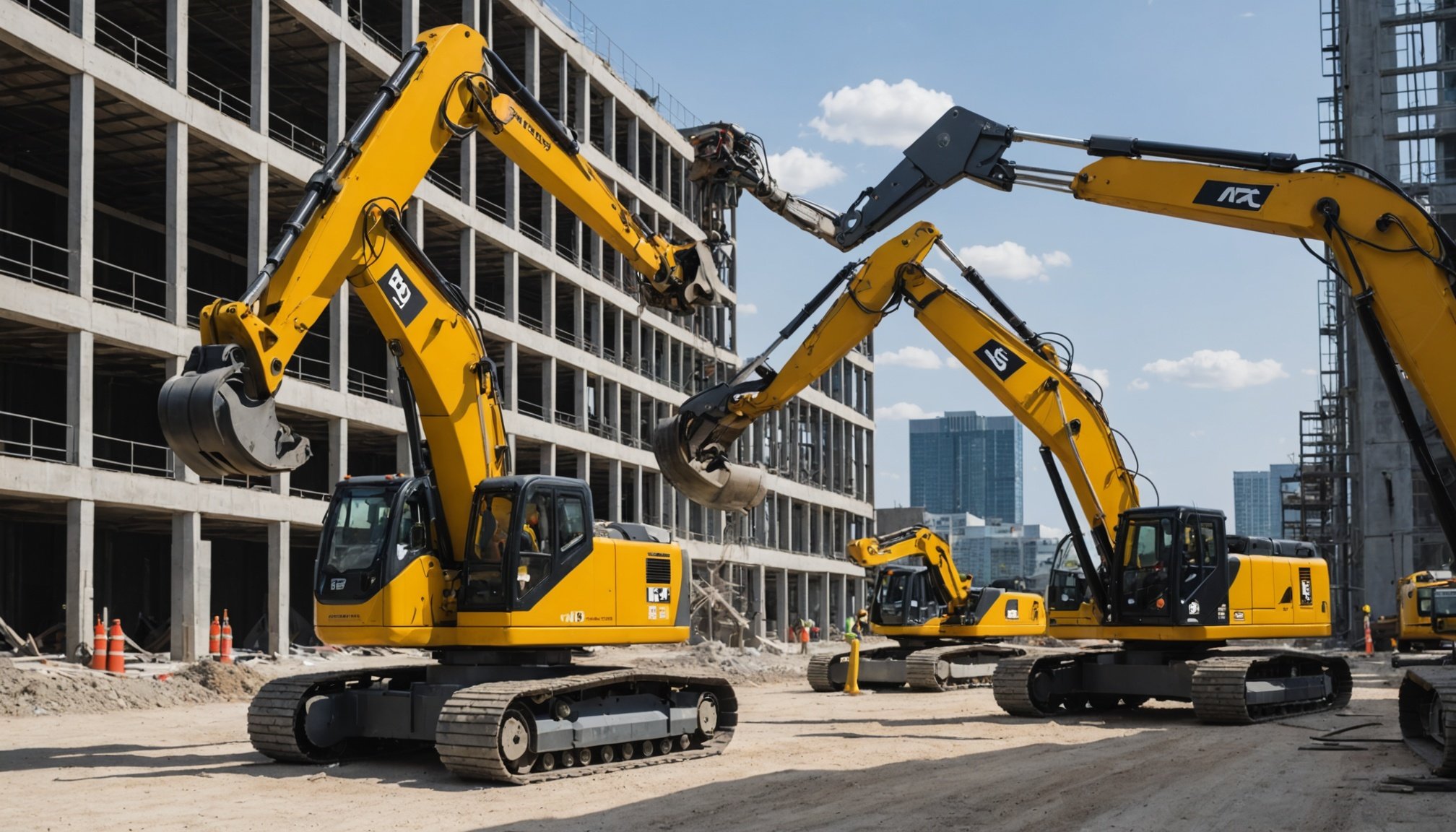Transforming Real Estate: The Role of Robotics in Advancing Construction and Maintenance Innovation
The real estate industry is on the cusp of a revolutionary transformation, driven by the integration of robotics and advanced automation technologies. This shift is not only enhancing the efficiency and safety of construction projects but also redefining the way buildings are managed and maintained. Here’s a deep dive into how robotics is transforming the real estate industry.
The Emergence of Robotics in Real Estate
Robotics in real estate is a relatively new but rapidly growing phenomenon. Initially, robots were limited to construction sites, performing repetitive and labor-intensive tasks. However, their role has expanded significantly to include property management, inspections, and even customer service.
Also to discover : Sustainable Solutions for Bustling Cities: A Comprehensive Guide to Low-Impact Development Strategies
Construction Automation
Construction automation is at the forefront of this change. Robots and automated machines are being used to streamline construction processes, reducing both time and costs. Here are some key ways robotics is impacting construction:
-
Speed and Efficiency: Robots can complete tasks much faster than humans, working around the clock without breaks or fatigue. This leads to quicker project completion times and maximized productivity. For example, drones are used for aerial surveys, providing detailed images and data that aid in planning and monitoring construction projects[1][2][3].
Also to read : Ensuring Fair Access to Amenities: Innovative Approaches for Property Managers in Large Residential Communities
-
Cost Reduction: The use of robots in construction reduces labor costs by minimizing the need for human workers on-site. Robots also reduce errors, which decreases the need for costly rework. Efficient use of materials further cuts down on waste, resulting in significant savings for real estate developers.
Smart Building Management
Robotics is not just limited to the construction phase; it is also revolutionizing smart building management.
Energy Efficiency
Robots can monitor and manage energy use in buildings, adjusting systems to save power based on occupancy. This includes controlling lights and heating systems, reducing waste and cutting costs. Smart sensors detect when areas are empty and adjust the lighting and temperature accordingly[1].
Predictive Maintenance
Robots equipped with advanced sensors can predict when building systems need maintenance, monitoring equipment for signs of wear and tear. This helps avoid unexpected breakdowns, extends the life of the equipment, and saves money by reducing downtime. Regular updates on the health of systems ensure everything runs smoothly[1].
Improved Safety Measures
Safety is a critical aspect of the construction and real estate industries, and robotics is making significant contributions here.
Hazard Detection
Robots can identify potential hazards such as gas leaks, structural weaknesses, and electrical faults. Early detection of these issues can prevent accidents and save lives. For instance, robots can detect harmful gases and alert authorities, spot cracks in walls or foundations, and find faulty wiring to prevent fires[1].
Future Prospects of Robotics in Real Estate
The future of robotics in real estate looks promising, with innovative technologies continually emerging.
Innovative Technologies
Drones and robotic surveyors are being used for site surveys and inspections, capturing high-resolution imagery and creating detailed 3D maps. Autonomous vehicles like robotic trucks and excavators are handling material transport and excavation tasks without human intervention, enhancing productivity and safety[2][3].
Here is a detailed list of some of the innovative technologies being used:
- Drones for Site Surveys: Drones equipped with high-resolution cameras and sensors survey large areas quickly, generating accurate topographic maps, 3D models, or point clouds.
- Robotic Surveyors: Robots inspect construction sites and gather real-time data, accessing areas that may be unsafe or difficult for human workers to reach.
- Autonomous Construction Vehicles: Robotic trucks and excavators work continuously, even in challenging conditions, reducing the need for manual labor and minimizing the risk of accidents.
- Automated Bricklaying Systems: These systems streamline the bricklaying process, reducing human error and increasing the speed of construction[2][3].
Integration of Robotics and Automation
The integration of robotics and automation is key to the transformation of the real estate industry.
Real-Time Decision Making
Intelligent systems equipped with sensors continuously monitor various parameters on construction sites, such as environmental conditions, material usage, and structural integrity. Drones provide aerial perspectives and detailed mapping capabilities, offering a thorough view of the site. This data enables robots to adjust their actions in real-time, ensuring construction activities align with sustainable practices[3].
Infrastructure Monitoring and Repair
Autonomous robots are identifying and addressing infrastructure issues in real-time, prolonging the lifespan of buildings and reducing the need for extensive repairs. These robots operate autonomously, performing tasks like filling potholes and ensuring the safety of streets, thereby minimizing environmental impact and preventing problems before they escalate[3].
Partnership and Innovation: Skyline Robotics and Alimak Group
A notable example of innovation in robotics and real estate is the partnership between Skyline Robotics and Alimak Group.
Next-Generation Automated Building Maintenance
Skyline Robotics and Alimak Group have partnered to create a next-generation automated Building Maintenance Unit (BMU). This collaboration combines Alimak Group’s expertise in vertical access solutions with Skyline Robotics’ cutting-edge automation. The result is a smarter and more integral approach to modern asset management.
“By automating BMUs, we are redefining how buildings are maintained while supporting architects and developers in creating innovative, sustainable structures,” said Philippe Gastineau, Senior Executive Vice President at Alimak Group[4][5].
Autonomous Window Cleaning
The integration of Skyline Robotics’ Ozmo, an industrial robotic arm that cleans windows autonomously, is a significant innovation. This technology not only provides data for best practices but also ensures compliance with Environmental, Social, and Governance (ESG) regulations. This partnership sets a new benchmark for facade access innovation, operational excellence, and future-proofing real estate assets[4][5].
Benefits of Automation in Building
The benefits of automation in building are multifaceted, contributing to sustainability, efficiency, and safety.
Efficiency and Precision
Automation reduces reliance on manual labor, accelerating construction processes and ensuring high standards of quality and accuracy. Robots equipped with advanced sensors like LiDAR and visual sensors navigate complex construction environments seamlessly, recognizing and interacting with site-specific objects efficiently[3].
Cost Savings and Sustainability
Automation in building offers significant economic and environmental benefits. Projects can be completed up to 50% faster than traditional methods, reducing labor costs by 30%. Additionally, automation minimizes human exposure to hazardous tasks, reducing accidents by 35%, and cuts energy consumption by 20%, contributing to a lower carbon footprint[3].
Practical Insights and Actionable Advice
For those looking to integrate robotics into their real estate projects, here are some practical insights and actionable advice:
- Assess Your Needs: Identify areas where robotics can add the most value, whether it’s in construction, maintenance, or property management.
- Invest in Training: Ensure that your workforce is trained to work effectively with robotic systems to maximize their benefits.
- Monitor and Adjust: Continuously monitor the performance of robotic systems and adjust workflows as needed to optimize efficiency and safety.
- Consider Sustainability: Look for robotic solutions that align with sustainable construction practices, reducing environmental impact and complying with ESG regulations.
The integration of robotics in the real estate industry is a game-changer, offering numerous benefits in terms of efficiency, safety, and sustainability. As technology continues to evolve, we can expect even more innovative solutions to emerge, transforming the way buildings are constructed, managed, and maintained.
Here is a comprehensive table summarizing the key applications and benefits of robotics in real estate:
| Task | Robotics Application | Benefits |
|---|---|---|
| Construction | Drones for aerial surveys, automated bricklaying systems | Faster completion times, reduced costs, increased accuracy |
| Inspections | Robots for safety checks, robotic surveyors | Improved safety, reduced human risk, detailed real-time data |
| Customer Service | Chatbots for inquiries | Enhanced customer experience, 24/7 support |
| Building Management | Automated systems for maintenance, security, energy management | Predictive maintenance, energy efficiency, extended equipment life |
| Infrastructure Monitoring | Autonomous robots for real-time monitoring and repair | Prolonged asset lifespan, reduced maintenance costs, minimized environmental impact |
| Window Cleaning | Autonomous robotic arms like Ozmo | Autonomous window cleaning, compliance with ESG regulations |
As Michael Brown, CEO of Skyline Robotics, aptly put it, “We are leading a new era of automated facade access,” which is just the beginning of a broader transformation in the real estate industry driven by robotics and automation[5].
In conclusion, the future of real estate is undoubtedly tied to the advancements in robotics and automation. As these technologies continue to evolve, they will play an increasingly critical role in making construction and building management more efficient, sustainable, and safe.











